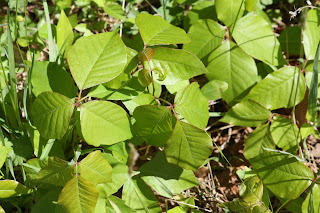One winter, when I was in the 5th grade, I came down with a mysterious rash on my face. It was blotchy, blistery, and itchy. My mom, a trained nurse, couldn't figure out what it was, nor by extension, how to help me. She theorized that maybe I had sat too close to the wood stove and burned my face (I do love a hot fire in the winter months). She wondered if I'd had an allergic reaction to the laundry detergent or perhaps the soap I used to wash my face. She applied cool compresses. She tried various itch creams. Nothing helped. Finally, she took me to the doctor who eventually determined I had poison ivy. In the dead of winter. How could that happen? No-one knew until a couple of weeks later when I brought home a school project.
We were studying the native people from our area- Wampanoags- and I had built a scale model of what we then called a wigwam, though I now know the proper term is wetu. And what, you ask, did I use to lash the poles together? You guessed it- poison ivy vines. Who knew you could get poison ivy from those? Who even knew what they looked like? That day, I vowed to learn what poison ivy looked like in every season so I wouldn't catch it again. Sadly, I have caught poison ivy since, even as an adult, (sometimes I swear I get it just by looking at it, I'm that allergic) but I do know exactly what it looks like, no matter the season.
Today, I offer these photos to help my New England readers avoid poison ivy. These were all taken in the last week, so this is what poison ivy looks like now. I'll be sure to post some photos during the fall and winter to help you avoid my itchy mistake!
 Notice the differences in the color and size of the leaves. Poison Ivy can look very different even in the same area. All of these photos were taken within roughly 1/4 mile of my house.
Notice the differences in the color and size of the leaves. Poison Ivy can look very different even in the same area. All of these photos were taken within roughly 1/4 mile of my house. One thing that is consistent is the presence of three leaves in a cluster. Usually those leaves are shiny. Sometimes those leaves are mostly green.
Other times the leaves are more red. (Especially when they are first coming out in the spring).
Sometimes it grows low to the ground like in the photos above. Other times it climbs up posts, signs, and trees as in these photos:
This one is about 3 feet tall.
This one climbs about 20 feet into the tree.
These last two photos are NOT poison ivy. This vine is sometimes confused with Poison ivy because it climbs the same way and has similar shaped leaves.
But look closely... there are 5 leaves in each cluster and the leaves are more jagged.
One final tip: poison ivy thrives along the edges. That is, in the area where one ecosystem transitions to another. For example, some of these photos were taken along the edge of a field where it transitions into forest (in partial to full sun), others along the edge of a brook (in partial sun), still others along the edge of a road (in full shade). Also watch for it along the edges of parks, paths, or trails.









I have had poison ivy a few times in my life, but the absolute worst time was when my ex-husband came home with the oil on his hands and touched me. I think it's important to note, that poison ivy can be contracted by contact with the skin of anyone who has touched the plant and has the oil on their skin. I suffered and had never even been anywhere near the plant itself.
ReplyDeleteExcellent point, Kristin. The same goes for clothes, gloves, shoes, etc. that may have the oils on them.
ReplyDelete